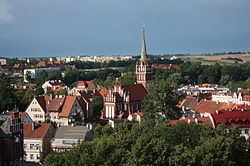Gmina Kętrzyn (urban gmina) Town rights 1357 Area 10.34 km² Local time Sunday 11:09 PM | Established 1329 Time zone CET (UTC+1) Population 28,000 (2006) | |
 | ||
Weather 2°C, Wind SW at 5 km/h, 97% Humidity Points of interest Burg Rastenburg, Muzeum im Wojciech, Konsulat Świętego Mikołaja | ||
Kętrzyn [ˈkɛntʂɨn] (German: Rastenburg, from Lithuanian and Old Prussian Raistpilis — "a castle in the swamps") ; 1945-1946 Polish: Rastembork), is a town in northeastern Poland with 28,351 inhabitants (2004). Situated in the Warmian-Masurian Voivodeship (since 1999), Kętrzyn was previously in Olsztyn Voivodeship (1975–1998). It is the capital of Kętrzyn County. The city was named after Wojciech Kętrzyński in 1946.
Contents
Map of Ketrzyn, Poland
History
The original inhabitants of the region were the Balt tribe of the Aesti, mentioned by Tacitus in his Germania (AD 98). The town, known in German as Rastenburg and in Polish as Rastembork, was established in 1329 in the State of the Teutonic Knights and was granted town rights in 1357 by Henning Schindekop.
Rastenburg and the surrounding district was the scene of the First World War's First and Second Battles of the Masurian Lakes. During the Second World War Adolf Hitler's wartime military headquarters, the Wolfsschanze (Wolf's Lair), was located in the forest east of Rastenburg. The bunker was the setting for the failed 20 July plot against Hitler. In 1945, the area suffered devastation from both the retreating Germans and advancing Soviets during the Vistula-Oder campaign. Some ruins of the Wolfsschanze remain. The town itself served as a Wehrmacht garrison town until it was occupied by the Red Army on January 27, 1945.
After the war, the town was transferred to Poland under border changes promulgated at the Potsdam Conference. Its surviving German residents who had not evacuated were subsequently expelled westward and replaced with Poles. The town was renamed Rastembork in 1945, and in 1946 to Kętrzyn after the Kashubian historian and activist Wojciech Kętrzyński.
People
Twin towns — Sister cities
Kętrzyn is twinned with:
